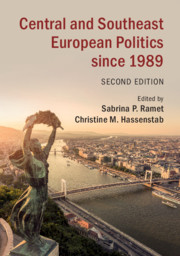Book contents
- Central and Southeast European Politics since 1989
- Central and Southeast European Politics since 1989
- Copyright page
- Dedication
- Contents
- Figures and Maps
- Tables
- Contributors
- Preface
- Glossary
- Guide to the Pronunciation of Central and Southeast European Words
- Additional material
- Part One Introduction
- Part Two Issues
- Part Three Central Europe
- Part Four Yugoslav Successor States
- Part Five Southeastern Europe
- 16 Romania: In the Shadow of the Past
- 17 Bulgaria since 1989
- 18 Albania since 1989: The Hoxhaist Legacy
- Part Six Present and Future Challenges
- Index
- References
18 - Albania since 1989: The Hoxhaist Legacy
from Part Five - Southeastern Europe
Published online by Cambridge University Press: 16 September 2019
- Central and Southeast European Politics since 1989
- Central and Southeast European Politics since 1989
- Copyright page
- Dedication
- Contents
- Figures and Maps
- Tables
- Contributors
- Preface
- Glossary
- Guide to the Pronunciation of Central and Southeast European Words
- Additional material
- Part One Introduction
- Part Two Issues
- Part Three Central Europe
- Part Four Yugoslav Successor States
- Part Five Southeastern Europe
- 16 Romania: In the Shadow of the Past
- 17 Bulgaria since 1989
- 18 Albania since 1989: The Hoxhaist Legacy
- Part Six Present and Future Challenges
- Index
- References
Summary
Albania's long road from communism to some form of market-oriented democracy has been complicated by the unburied ghosts of its Hoxhaist past. The most brutal aspects of Enver Hoxha’s regime (which lasted from 1944 to his death in 1985) are long gone, including its state-of-siege isolation, its endless political murders, its prisons, its forced labor camps, and the hardships of long internal exile. But some aspects of authoritarian rule live on: the elite’s general disregard for the well-being of the people and for the best interests of the state, brutal and intolerant politics, and an inability to consolidate the rule of law. These issues have plagued both of Albania's major post-communist parties, the Socialist Party and the Democratic Party. When communism finally collapsed in 1990–1991, the Democrats under Sali Berisha came to power. While Berisha presided over profound economic and social change, his party became a personal vehicle for his own power as, like Hoxha, he refused to permit internal dissent, with his security forces and thugs being deployed to disrupt opposition rallies, and to harass and assault opposition supporters, candidates, and the press. With some interruptions, Berisha’s increasingly corrupt regime survived until 2013 when the Socialists under Edi Rama, the young mayor of Tirana, were swept to power. While not quite the promised “Renaissance”, the Rama regime has moved Albania closer to its goals, through fairer elections and the beginnings of other reforms. Rama was duly rewarded with the gift of European Union Candidate status. But many of the old ways linger. Corruption remains all-pervasive, politics remains brutal, and it is the people of Albania who suffer. Albania’s “transition” remains far from complete.
Keywords
- Type
- Chapter
- Information
- Central and Southeast European Politics since 1989 , pp. 477 - 506Publisher: Cambridge University PressPrint publication year: 2019
References
Further Reading
- 2
- Cited by

